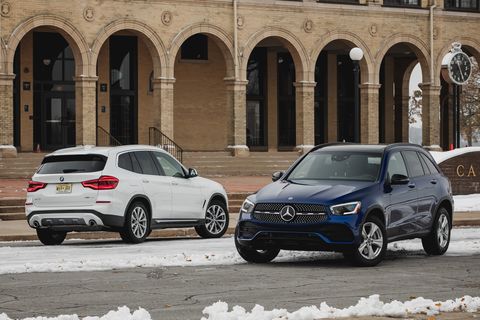Bmw 3 2018 Vs 2019

Michael Simari Car and Driver
It's perhaps best to think of the Mercedes-Benz GLC and BMW X3 as the Honda CR-V and Toyota RAV4 of the luxury SUV world. While they have more brand power than those mainstream SUVs, these two compact luxury crossovers are similarly important to their brands. Just as the CR-V and RAV4 have eroded the sales of the Accord and Camry, the GLC and the X3 are what shoppers have turned to instead of the C-class and 3-series.
The current-generation GLC arrived for 2016 as a replacement for the previous GLK-class. Mercedes did, however, give the GLC a comprehensive update for 2020 that includes revised styling, an updated engine for the four-cylinder GLC300 model, and an array of new tech features. BMW completely redid the X3 for the 2018 model year and hasn't changed in any significant way since. Like the GLC300, the X3 30i is powered by a turbocharged 2.0-liter inline-four. Both vehicles come standard in rear-wheel-drive form, with all-wheel drive adding $2000 to the bottom line.
Michael Simari Car and Driver
For this test, we drove a 2019 X3 xDrive30i back to back with a 2020 GLC300 4Matic for our subjective evaluation. Wet weather prevented us from being able to perform instrumented testing on the X3, but it is mechanically identical to the 2018 X3 xDrive30i we previously tested, and we're comfortable relying on that earlier X3's objective numbers.
On the Road
Although it benefits from a slight horsepower bump for 2020, Mercedes's 255-hp turbocharged 2.0-liter inline-four still lacks the smoothness, response, and power delivery of BMW's 248-hp engine. The numbers tell a different story. Acceleration testing shows a clear advantage for the GLC300 4Matic, which can go from zero to 60 mph in 5.4 seconds, or 0.7 second quicker than the 175-pound-heavier X3 xDrive30i. What the numbers don't tell you is that the BMW's engine simply works better in the real world and sounds more engaging than GLC's engine. We have to give some credit to BMW's ZF eight-speed automatic transmission, which downshifts more authoritatively and willingly than the Benz's more relaxed nine-speed automatic.
Michael Simari Car and Driver
The X3 did manage to beat the GLC's fuel economy numbers. In our hands, the X3 xDrive30i averaged 22 mpg versus 20 mpg for the GLC300 4Matic. In our steady 75-mph highway test, the BMW returned a strong 31 mpg, or 2 mpg better than its EPA highway estimate. In contrast, the Benz posted 25 mpg in the same test, which is 3 mpg lower than its EPA highway number.
Driving both back to back reveals that the X3 is the more athletic of the two. It has better body control, heavier and more direct steering, and a playful eagerness to challenge corners. The Benz's driving experience is subdued by comparison. We didn't love the GLC300's light-effort steering and slightly mushy brake pedal, although the Mercedes did perform slightly better in our 70-mph-to-zero braking test than did the BMW with its optional M Sport brakes. For buyers who like to drive, the X3 has been graced with sports-sedan moves. We'd even go so far as to say that you might mistake it for a 3-series if not for its elevated seating position.
Michael Simari Car and Driver
The Inside View
We'll call it a tie in terms of rear-seat accommodations, as both the BMW and the Mercedes have comfortable cushioning in back and a reasonable amount of room for adults. In terms of cargo space, their spec sheets would have you believe that the X3 boasts a whopping 10 more cubic feet of cargo space than the GLC, but we're skeptical of those measurements because we fit eight carry-on-suitcase-size boxes in the GLC's cargo area and only seven in the X3.
Mercedes introduced a new infotainment system to the GLC as part of its update for 2020. It's called MBUX, and we're not sold on its touch-heavy interface, which incorporates a touchscreen, a touchpad controller on the center console, and touch-sensitive buttons on the steering wheel. The displays themselves look crisp, but we prefer turning physical knobs such as the one that's used to control BMW's (somewhat) more intuitive iDrive infotainment system. Turning a knob requires less concentration than swiping or pinching on a virtual touchpad, and the BMW setup is less distracting to use while driving.
Michael Simari Car and Driver
We'll hand it to Mercedes in terms of interior style, though, as the GLC's cabin is far flashier than the BMW's. There's rich detailing of the buttons and knobs, and the wood trim looks and feels expensive. The X3 measures up in terms of fit and finish, but the BMW's dashboard design lacks the panache and wow factor of the Benz's.
The Bottom Line
For the 2020 model year, the X3 xDrive30i starts at $44,945 and the GLC300 4Matic begins at $45,595, with both of our examples sporting generous luxury and technology options that pushed their as-tested prices to nearly $60K. If we were writing the check, it's the BMW X3 that we'd rather take home. While the Mercedes-Benz GLC300 is refined and luxurious, the X3 is a near match for the GLC in those measures, and the BMW adds a superior driving experience, a better powertrain, and a more intuitive infotainment system. It's that extra degree of athleticism that is built into the X3 that earns it a narrow win over the GLC.
Michael Simari Car and Driver
This content is created and maintained by a third party, and imported onto this page to help users provide their email addresses. You may be able to find more information about this and similar content at piano.io
Source: https://www.caranddriver.com/reviews/comparison-test/a30340309/2020-mercedes-benz-glc-vs-2019-bmw-x3/

0 Komentar